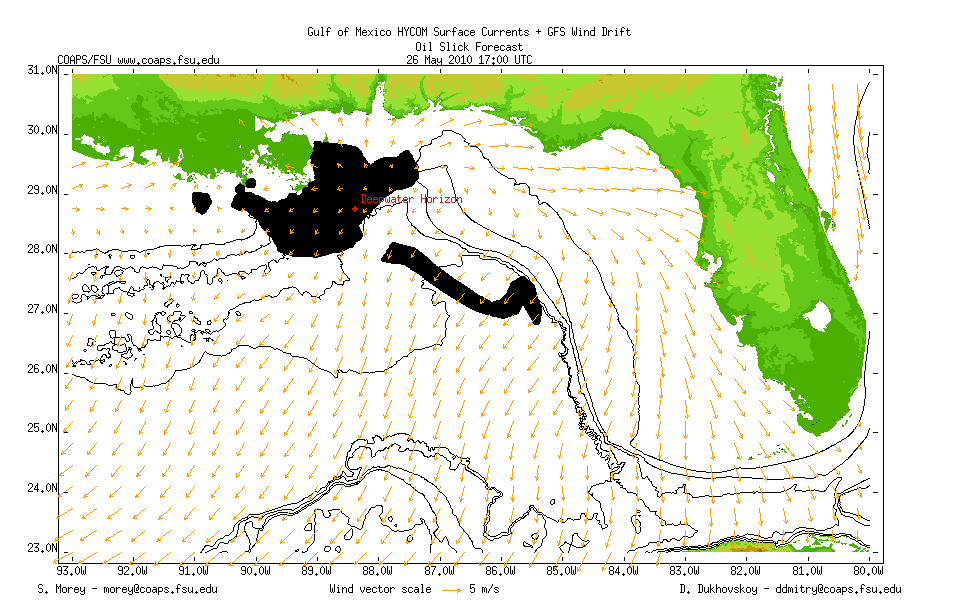
"Oil stays away from South Florida for now
South Florida has gained a temporary reprieve from the danger of globs of oil arriving from the spill in the Gulf of Mexico, according to the state's top environmental official.
Michael Sole, secretary of the Florida Department of Environmental Protection, said that two disruptions in the loop current, which leads from the Gulf of Mexico to the Gulf Stream off the southeast Florida coast, should keep the oil away, at least for now.
An eddy at the top of the current has drawn away the portion of the slick that had been caught in the current. And at the south end, another eddy has pinched off the current entirely, he said. "This is great news," Sole said, speaking at a news conference with Gov. Charlie Crist at the state's emergency operations center in Tallahassee. "And what it does is keep the oil from getting into the Florida Straits."
Oil — at least in the degraded congealed form of tar balls — had been expected to arrive in the Keys and South Florida within the next two weeks or so, but Sole said the disruptions in the current have stopped any movement of oil to the area. But the main part of the slick, which remains dozens of miles from the loop current, could constitute a much greater threat to South Florida if it got caught in the current. Also there is an unknown amount of oil beneath the ocean surface from the still-leaking well."

Continued at:
http://www.sun-sentinel.com/news/bro...,6559446.story
... and where's Waldo the AUV?

"What will 'Waldo' find: Mote Marine releases robot into Gulf to search for oil
By KATY BISHOP
KEY WEST — This time, we know where Waldo is — it’s his turn to look for something.
Researchers hope that a robot named Waldo will help them track oil in the Loop Current in waters off Key West. Scientists and engineers with Mote Marine Laboratories released the yellow, torpedo-shaped autonomous underwater vehicle into the waters about 25 miles northwest of the island Tuesday afternoon.
The robot, programmed by researchers, will swim along a designated course, diving deep and rising again and again, looking for oil in the water. If it finds oil, it will record the geographic position and depth, as well as the concentration — and then send that information by satellite to researchers who are monitoring it."
"The robot detects pure oil, oil with dispersants and weathered oil. Two similar robots are already deployed in the waters closer to the spill. Mote put another one in the Gulf last week off Venice and plans to put another one in the waters off the Keys. “The biggest value that this thing has is it’s 24/7 data,” said Alan Hails, an oceanographic instrument engineer with Mote. Over a period of about three weeks, Waldo will travel almost due west to a point about 50 miles north and 30 miles west of Dry Tortugas, sending information each time it surfaces."
"Experts predict by the time the oil reaches the Keys it will be weathered into tar balls, which float on the surface, said David Vaughan, director of Mote’s center for coral reef research, who is captaining the boat. Tar balls probably wouldn’t affect the coral reefs as much, since the reefs are on the bottom, but they could get stuck in sensitive mangrove shorelines or sea grass beds. More concerning for corals is the chemical dispersant used by British Petroleum, he said. It’s been shown to be highly toxic to both hard and soft corals, with a 85 to 100 percent mortality rate."
"When it’s time to dive, Waldo takes on water, making itself heavier, and when it wants to rise to the surface, it pushes that water out, Hails explains. At the surface, a bladder inflates with air, popping the tail out of the water so the antenna can communicate with the satellite. The scientific instruments are clustered in the center of the robot’s torpedo-shaped body, where there are four windows for Waldo to send out LED light beams. Sensors read the light reflected back from the water, calculating if there’s oil in the water by the amount reflected back. And that’s just the start — there are also other sensors that make sure that organic matter isn’t misidentified as oil, and devices that log temperature and depth and more."
 http://www.naplesnews.com/news/2010/...ase-robot-gul/
http://www.naplesnews.com/news/2010/...ase-robot-gul/